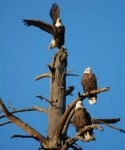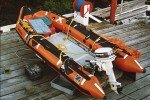Death on Price Island
McInnes marked – view Larger map
On one of our beachcombing trips Roger Mogg and I headed up this narrow deep inlet on the East side of Price Island, just a few kilometres from McInnes Island Lighthouse. (see interactive map above – red marker is McInnes Island; Price Island is NE a bit and labelled as such)

The weather was warm and the sea in the inlet was smooth – not a ripple on it – which should have alerted us that something was wrong because we had just rounded the lower corner of Price in a bit of a chop. As we motored slowly up the inlet we noticed hundreds of bald-headed eagles in mature and young plumage. They were sitting on the beach, in the trees and on any available stone.

The inlet was no more than one hundred yards long and a maximum of 20 yards wide and ended at a rocky beach. None of the eagles appeared alarmed by the sound of the outboard and we found out the reason why.
At the head of the inlet was a stripped whale carcass. Not a piece of meat on it as far as we could see. No smell, no blood – only scattered bones and ribs. There was no way we could identify the whale from the few remaining parts although maybe a professional would have had no problem.
The eagles had gorged themselves on the flesh and fat as it rotted in the hot sun, and were probably waiting for another one to wash in, or just enjoying the feel of being full.
As we jumped out of the boat at the rocky shoreline we noticed a shiny film on the rocks as a barely-noticeable swell lifted a bit of seawater onto the beach. The tide was rising towards the carcass, but even from the distance of a few yards, there was no smell of death. Just quiet, warm sun, and hundreds of eagles staring at us. The feet of our hipwaders slipped on the rocks and scared a few feeding rock crabs.

There really was nothing much left on the carcass – no teeth, no baleen, no souvenirs at all. We loaded a couple of the smaller bones into the Canova and started to push off again.
Then we noticed the water in the wake of the bow. On the way in, the sun had hidden the message. The water in the inlet was covered on the top with at least one inch (2.5 cms) of clear whale oil!
In the hot sun the fat had rendered down and flowed down to cover the complete inlet. The slight chop on the outside of the bay tended to hold it there. The boat, the motor, our waders – and luckily nothing else – were all covered with a thin layer of oil. We carefully pushed the boat out, trying not to think of falling into that mixture of oil and water.
Luckily the Canova is an easy boat to manouever and board. We headed slowly out past the eagle sentinels, taking a last glance at the bones on the beach. Speed was not essential here as rubber inflatables sometimes throw a nice spray from their bow wave and we didn’t want to risk a bath.
 Once outside and looking back again we could not see where the oil ended and the actual clean water began – not a line. No wonder we never saw it on the way in.
Once outside and looking back again we could not see where the oil ended and the actual clean water began – not a line. No wonder we never saw it on the way in.
Amazingly, cleanup was not a problem! The oil was highly refined by the hot sun and cleaned of any residue by the sea and so there was no discernable smell at all.